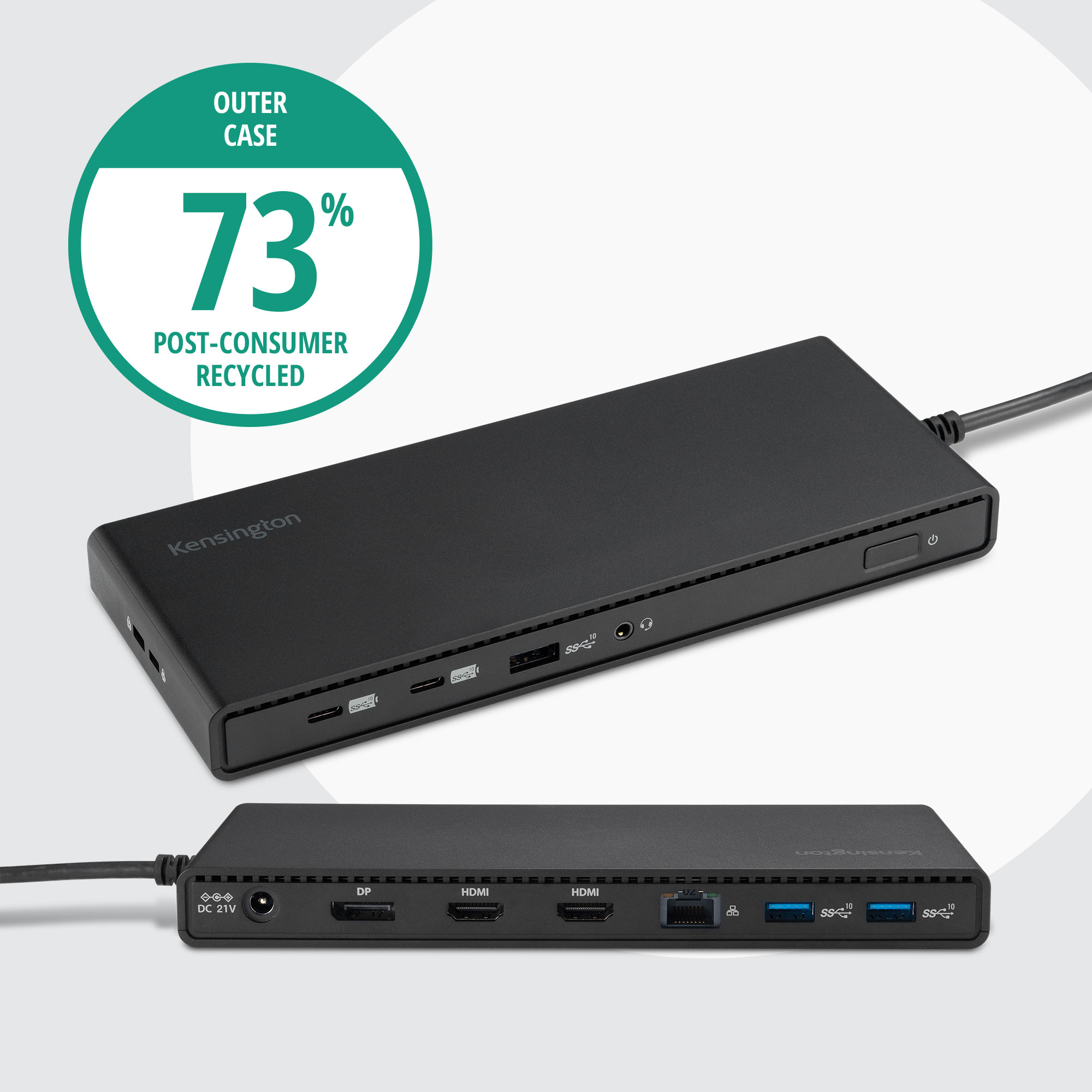
It’s a big data world – and if your system doesn’t have the connections necessary to move large amounts of data quickly, you’re going to find yourself lagging (literally) behind. Fortunately, the innovations from Intel continue to keep pace with the growth of consumer processing needs, and with their newest addition to the family, Thunderbolt™ 5 is poised to keep that legacy going.
The high-speed connectivity of the Thunderbolt™ connector emerged as an innovation on the ubiquitous USB port, an essential component for data transfer. Yet, as the amount of data continues to grow between devices, the need for faster speeds, improved performance, and easier connections are all becoming increasingly important.
Intel's Thunderbolt™ technology revolutionized the computing industry by offering high-speed connectivity that integrates data transfer, video output, and power delivery into a versatile interface. Now, Intel has announced Thunderbolt™ 5 - an impressive upgrade to the lineup, representing a remarkable advancement in the Thunderbolt™ series.
So, what do you need to know about the Thunderbolt™ 5 compared to its predecessors 3 and 4? Let’s break down the tech specs we know right now and how the 5 series will help you get the most out of your data transfers.
A Peak at Thunderbolt™ 5
Before comparing performance to the Thunderbolt™ 3 and 4, let’s break down what we can expect the Thunderbolt™ 5 to bring to the table. Users can connect up to three 4K displays at 144Hz – or two 8K displays at 60Hz. But the visual performance isn’t the only benefit of upgrading to Thunderbolt™ 5.
Improved Bandwidth
One of the notable features of Thunderbolt™ 5 is its enhanced bandwidth. Unlike previous iterations, Thunderbolt™ 5 provides a significant bandwidth enhancement of 80 Gbps (gigabits per second) bi-directionally. This is a notable increase over the 40 Gbps offered by Thunderbolt™ 3 & 4 - nearly doubling the transmission speed.
Another exciting announcement from Intel is the new Bandwidth Boost feature, allowing Thunderbolt™ 5 to theoretically reach a bandwidth of 120 Gbps. This Thunderbolt™ 5 feature allows for an instant boost in bandwidth during heavy video or audio workloads.
Faster Data Transfer
Thunderbolt™ 5 supports higher data transfer speeds of up to 64 Gbps thanks to the PCI Express Gen 4 interface. This means if you have a high-end Solid State Drive (SSD), you can now use it in an external enclosure without compromising on speed – great for when you need to quickly move large files between devices.
If you're into gaming or need a powerful graphics card for professional work, Thunderbolt™ 5 allows you to connect external graphics card enclosures. Unlike previous Thunderbolt™ generations, which were limited to 32 Gbps, the new 64 Gbps speed removes previous bottlenecks, allowing for high-end desktop Graphics Processing Units (GPUs) perform at their best.
Improved Power Delivery
When transitioning from Thunderbolt™ 4 to Thunderbolt™ 5, you’ll see a notable improvement in power delivery. Thunderbolt™ 5 an deliver a minimum of 140W, which is significantly higher than the 100W offered by Thunderbolt™ 4.
Even better, it can be configured to deliver up to 240W, which is a substantial amount of power. While we haven't seen laptop manufacturers adopting the 240W mode of USB Power Delivery yet, Thunderbolt™ 5 supporting it shows that the future is bright.
This higher power delivery capability is especially useful for powerful gaming laptops that traditionally rely on a separate DC barrel connector for their power needs.
Upgraded Compatibility
Compatibility is a significant concern when it comes to adopting new technology. Thunderbolt™ 5 addresses this concern by aligning with industry standards such as USB4® Version 2.
Users can still connect back to Thunderbolt™ 4 capable systems, and the same is true of 4 cables to 5-capable ports. However, if you are using a Thunderbolt™ 4 cable on a Thunderbolt™ 5 port, you’ll find yourself limited to the performance of the cable. Make sure to always check for the compatibility of any hardware you are connecting to your Thunderbolt™ 5 port.
New Signaling Technology
With the integration of a new signaling technology called PAM-3, Thunderbolt™ 5 aims to enhance performance while working well with the existing hardware infrastructure.
PAM-3 technology is a kind of modulation that helps achieve higher data rates – bridging the gap between current hardware capabilities and the higher performance potential that Thunderbolt™ 5 introduces. With PAM-3, users can enjoy greater speeds than traditional Thunderbolt™ 4 cables.

Which Thunderbolt™ is Right for Me?
While the new and improved Thunderbolt™ 5 brings impressive performance to any workstation, is it the right option for you? Choosing between the available Thunderbolt™ 3 and 4 - or the new 5 - depends on your power and data needs today and what you might need in the future.
For Everyday Users and Basic Needs: Thunderbolt™ 3
- Data Transfer: With a data transfer rate of 40 Gbps, Thunderbolt™ 3 provides ample bandwidth for general use cases like transferring files, streaming videos, and more.
- Display Support: If you need to connect to a single 4K display, Thunderbolt™ 3 has got you covered.
- Power Delivery: Delivering up to 100W of power, it can charge your laptop and other devices efficiently.
- Compatibility: Compatible with USB-C® connectors and cables, allowing for straightforward connections to various devices.
For Prosumers and Enhanced Visuals: Thunderbolt™ 4
- Reliable Data Transfer: While maintaining a 40 Gbps transfer rate, Thunderbolt™ 4 requires a higher minimum data transfer speed, ensuring a more reliable performance for high-speed data transfers.
- Better Display Support: If you're into high-resolution visuals, Thunderbolt™ 4 supports two 4K displays or one 8K display, enhancing your viewing or editing experience.
- Certified Compatibility: With stricter certification requirements, Thunderbolt™ 4 ensures a more standardized performance across different devices.
- Power Delivery: Like Thunderbolt™ 3, it delivers up to 100W of power, catering to your charging needs.
For Power Users and Future-Ready Enthusiasts: Thunderbolt™ 5
- Superior Data Transfer: A significant leap to 80 Gbps, extendable to 120 Gbps with Bandwidth Boost, Thunderbolt™ 5 is tailored for high-speed data transfer needs.
- Advanced Display Support: Although exact display support details are pending, the increased bandwidth will likely accommodate higher resolution displays and multiple 8K displays.
- Enhanced Compatibility: Building on industry standards, including USB4® V2, Thunderbolt™ 5 ensures broad compatibility with previous Thunderbolt™ versions and USB.
- Robust Power Delivery: With a minimum power delivery of 140W, configurable up to 240W, it's a robust choice for high-power-demand devices like gaming laptops.

Find All Your Thunderbolt™ Products at Kensington
The Thunderbolt™ 5 and compatible ports are expected to begin hitting the market in 2024 – and here at Kensington, we are looking forward to bringing you the latest products designed to take full advantage of everything the latest generation brings.
Want to learn more about Thunderbolt™-compatible products? Check out our full range of Thunderbolt™ and USB-C® docks, adapters, cables, and locks. At Kensington, we proudly offer the best products for every Thunderbolt™ generation, so you can find the perfect solution for your device.
Explore Kensington's Thunderbolt™ Solutions and maximize your productivity.
